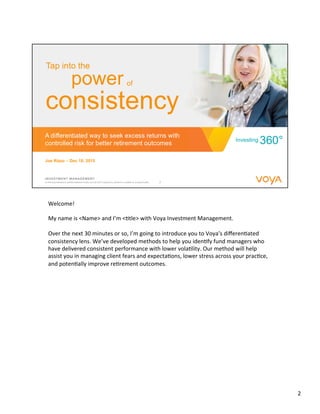More Related Content
Similar to Presentation Voya360
Similar to Presentation Voya360 (20)
More from Scott Ferguson (6)
Presentation Voya360
- 5. Far and away the most common fund evalua5on measures are some combina5on of
historical performance data, generally over fixed 1, 3, 5- and 10 year periods. There’s
nothing inherently wrong with this approach…
…but as you know, these tradi5onal methods have some limita5ons.
As typically applied, tradi5onal performance evalua5ons just give you a snapshot view
of a par5cular point in 5me over the past 1, 3, 5- and 10 year periods. They all include
the most recent 1-year period. Similarly, the most recent 3-year period appears in the
3-year, the 5-year and the 10-year results, and so on. This known as “end period
dominance” a problem that actually limits the amount of informa5on and focuses it on
the most recent periods.
And the raw returns alone can’t tell you if a fund manager’s success is due to skill or
mere luck. Or how a fund behaves when markets are going down. Or if a fund manager
can regularly iden5fy undervalued securi5es that will appreciate faster than market
averages.
6
- 15. To ensure validity and credibility in our measurement and analysis, we took a broad
perspec5ve by analyzing rolling 3-year periods rather than the more common fixed
term periods of 1, 3, 5 or 10-years.
As typically applied, tradi5onal performance evalua5ons just give you a snapshot view
of a par5cular point in 5me over the past 1, 3, 5- and 10 year periods. They all include
the most recent 1-year period. Similarly, the most recent 3-year period appears in the
3-year, the 5-year and the 10-year results, and so on. This is known as “end period
dominance,” a problem that actually limits the amount of informa5on and focuses it on
the most recent periods.
Rolling periods eliminate the tendency to over-emphasize recent returns, which is
par5cularly important today given the bull market we’ve experienced over the past 6
years.
16
- 16. Fund manager style preferences and investment techniques can only be es5mated over
reasonably long 5me periods. Rolling periods provide a more realis5c viewpoint, by
covering mul5ple market cycles, equally weigh5ng results across both up and down
markets, and minimizing any bias inherent in recent events.
More than 90% of a stock fund’s performance comes from the manager’s “style,” such
as growth or value, or the fund’s category, such as large cap or small cap. Styles go in
and out of favor, and on average, the in-favor periods tend to last about 2½ years. So
it’s quite possible that all of a par5cular fund’s “excess returns” over any specific three-
year period could simply be due to that style being in favor, rather than any repeatable
manager processes and philosophies.
[Source: Style generaliza5on based on monthly rela5ve performance of Russell U.S.
Large-cap Growth vs. Russell U.S. Large-Cap Value, 1979-2014. Source: Russell
investments, Voya Investment Management.]
17
- 21. The data points on this chart place the historical excess returns into a two-dimensional
space with the applicable downside risk data on the horizontal axis. The data points are
averages for the excess returns and risk for the funds that ranked in the top half of
their respec5ve categories in terms of both excess returns and the selected
performance factor.
The benefits of iden5fying funds on the basis of these measurements are evident: all
factors demonstrated the ability to enhance excess returns, and all but up-capture
(because is falls to the right of the “Overall Average” point) poten5ally supported risk
reduc5on.
METHODOLOGY: The analysis was based on rolling 3-year returns with the rolling
window advanced one month at a 5me for the A-share class at net asset value for 1,046
funds over the period 2005-2015. The fund categories were Large-Cap Growth, Large-
Cap Blend, Large-Cap Value, Mid-Cap Growth, Mid-Cap Blend, Small-Cap Growth, Small-
Cap Blend, Intermediate Bond, Senior Bank Loans and High Yield Bond. All funds had at
least a 3-year return history and $1 million in assets as of 9/30/2015.
Past performance is not a guarantee of future results
22
- 29. Some factors are included in all the evalua5ons—notably the overall ra5o between
upside and downside capture—but varia5on in factor choices and weights permiked
customized results for each of our three risk tolerance groups, as follows:
Re-rees
• The most conserva5ve investors, presumably sa5sfied by funds that closely track
benchmarks and have lower downside risk than other funds, on average.
• Sor5no Ra5o, Down Capture, and R-Squared are emphasized to iden5fy funds with
very low poten5al for actual losses and a return pakern that is close to a chosen
benchmark.
Pre-Re-rees
• These investors are assumed to prefer a secure, balanced, middle-of-the-road
approach, offering consistent, above-benchmark returns with average downside
vola5lity.
• Informa5on Ra5o, Upside Capture, and R-Squared are heavily weighted to iden5fy
funds that show above average skill, risk-adjusted returns, and steady, above-
benchmark results.
Accumulators
• The youngest investor group is characterized by an expecta5on of the highest
poten5al returns and a willingness to accept typical or above average vola5lity.
• Informa5on Ra5o and Upside Capture are heavily weighted to iden5fy funds that
show above average returns in up markets—to deliver more return poten5al than
funds in the other groups but with commensurately higher risk of loss.
30

